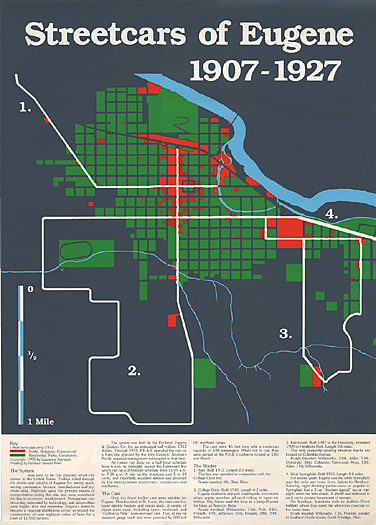|
TEXT OF POSTER
Key
Urban land uses circa 1912
(Orange) Public, Religious, Commercial
(Green) Residential, Parks, Cemeteries
Copyright 1990 by Laurence Aurbach
Printing by Horizon Screen Print
The System
...was said to be the greatest small-city
system in the United States. Trolleys rolled through the streets
and suburbs of Eugene for twenty years, serving commuters, farmers,
manufacturers and joyriders alike. Railroads were the primary means
of transportation during this era, and were considered the key to
economic development. Horsepower was becoming outmoded by technology,
and automobiles were slow, fragile and expensive. Eugene's desire
to become a regional distribution center prompted the construction
of over eighteen miles of lines for a town of 11,500 persons.
The system was built by the Portland, Eugene
& Eastern Co. for an estimated half-million 1912 dollars. Through
1915, PE&E operated the cars on a franchise granted by the City
Council. Southern Pacific assumed management subsequent to that
date.
All routes ran daily on a half-hour schedule
from 6 a.m. to midnight, except the Fairmount line which ran on
a 20-minute schedule from 11:45 a.m. to 7:30 p.m. A ride on the
streetcars cost 5 to 10 cents, and reportedly excellent service
was provided by the twenty-seven motormen, conductors and mechanics.
The Cars
Only the finest trolley cars were suitable for
Eugene. Manufactured in St. Louis, the nine cars featured electric
heaters and rattan seats. A variety of styles were used, including
open, enclosed, and "California Style" semi-enclosed cars.
They all ran on standard gauge track and were powered by 500-volt
DC overhead cables.
The cars were 45 feet long with a maximum capacity
of 100 passengers. When not in use, they were parked at the PE&E
carbarns located at 13th and Beech.
The Routes
1. Blair: Built 1912. Length 2.0 miles.
This line was operated in conjunction with the
College Crest line.
Roads traveled: 8th, Blair, River.
2. College Crest: Built 1910. Length 6.2 miles.
Eugene residents enjoyed countryside excursions
when warm weather allowed riding in open-air trolleys. Day hikers
used this loop as a jumpoff point for hikes up Spencer Butte.
Roads traveled: Willamette, 11th, Polk, 18th,
Friendly, 19th, Jefferson, 24th, Friendly, 28th, 29th, Willamette.
3. Fairmount: Built 1907 to the University; extended
1908 to Hendricks Park. Length 5.6 miles.
The only presently existing streetcar tracks are
located on Columbia Avenue.
Roads traveled: Willamette, 11th, Alder, 13th,
University, 26th, Columbia, Fairmount, Moss, 13th, Alder, 11th,
Willamette.
4. West Springfield: Built 1910. Length 4.8 miles.
For several years, Eugene was dry while Springfield
was the only wet town from Salem to Medford. Saturday night drinking
parties were so popular in Springfield that a 2-car "drunken
special" ran at midnight, when the bars closed. A sheriff was
stationed in each car to prevent harassment of women.
On Sundays, hundreds rode to Judkins Point ballfield,
where they spent the afternoon cheering on the home team.
Roads traveled: Willamette, 11th, Franklin, parallel to Southern
Pacific tracks, South A bridge, Main.
|





